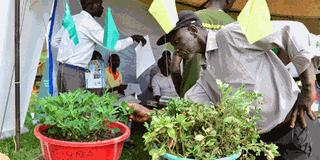Guide for hybrid crops to plant this season

Farmers have cleared their gardens and sowing the seeds is ongoing in several parts of the country. Agronomists recommend hybrid varieties which will beget high yields.
What you need to know:
- The first rainy season of 2021 has started.
Early this week, the Uganda National Meteorological Authority (UNMA) predicted heavy first rainy season which has already started.
Seeds of Gold talked with several agronomy experts breeding various crop varieties and below they share the crops farmers should plant this season.
Beans
The head of the bean programme at the National Crop Resources Research Institute (NaCRRI) in Namulonge Dr Stanley Nkalubo explains that farmers are advised to grow hybrid bean varieties which are high yielding.
The preferred hybrid varieties which are early maturing are Nabe 15, 16, 17 and 19 which farmers have been growing for quite a period of time.
However there are newly varieties which have an increase in iron from 20-25 per cent over the ordinary ones, early maturity and can require less rainfall.
These varieties mature in 60-75 days for the bush varieties (Narobean1, Narobean2 and Narobean3 and 85-95 days to maturity for the climbers Narobean4C and Narobean12C).
Hybrid tubers
Dr Titus Alicai, the former head of root crops at NaCRRI says cassava takes 9-12 months for the roots to be ready for harvesting. However since a number of cassava varieties have succumbed to Cassava Brown Streak Virus (CBSV). Alicai advices farmers to plant Naro Cas1 variety which is resistant to CBSV. Other recommended varities are NASE14, 19 and Naro Cas2..
Sweet potatoes
Another important crop farmers must plant this season is sweet potatoes which serves both as income earner and for food security in households.
Irish potatoes
Dr Abel Arinaitwe of Naro tips farmers to consider planting Irish potatoes. He recommends varieties of Naropot 1 to 4 which are known as Victoria varieties and Kachpot 1 and 2 with yield capacity of seven to eight tonnes per hectare.
Coffee
Ms Teopista Nakkungu, a coffee farmer and scientist dealing in coffee value chain says elite coffee seedling varieties which are called Kituuza Kawanda series are the recommended varieties for farmers to grow this season.
The seedlings of KR 1-7 are available with coffee nursery operators with initial seedling from the National Agricultural Research Laboratories (NaRL) Kawanda. She also recommends the recently released KR9 to10 varieties from the National Coffee Research Institute, Kituuza.
Semi-arid crops
The crops for eastern and northern corridor are catered for by the National Agricultural Semi-Arid Resources Research Institute (NaSARRI) in Serere District. The director general of the institute, Dr Michael Ugen notes that farmers in this region have various crops to plant this season just as they have been doing. These crops include;
Groundnuts
Naronut2T high yielding Spanish‐type of groundnut which produces two seeds per pod. Naronut2T was released in 2019 after a cross cultivar selected from a cross between ICRISAT advanced lines ICGV‐SM 86715 and ICGV‐SM 90704.
Naronut2T has significantly higher pod yields of 1418.0 kg/ha than Serenut 4T which yields 571.9 kg/ha. The shelling percentage for Naronut2T is 50.1 per cent compared with 58.4 per cent for Serenut 4T. Naronut2T contains a higher protein content than Serenut 4T, 25.7 versus 23.6 per cent, respectively, but has a lower oil concentration, 39.6 versus 42.9 per cent, respectively. Compared with Serenut 4T, Naronut2T is a higher yielding cultivar with resistance to groundnut rosette disease and late leaf spot disease.
The ordinary Naronut1 and 2 which are red in colour the yield rate is similar to NaronutT2 and are resistant to pests and diseases as well as drought tolerant.
Other recommended varieties include Serenut5R (red) Serenut 6T (white), Serenut 7T, 8R, 9T, 10R, 11T, 12R, 13T and 14R. These have resistance to the other pests and diseases.
Sorghum
Dr Ugen emphasises that the varieties his team is promoting are Narosorg1to4 which yields three tonnes per hectare and is drought tolerant.
Millet
The millet varieties are Naromill1-5 which are early maturing and yield rate is 2.5 tonnes per hectare.
Green gramm
Green gramm according to Ugen is becoming a popular crop amongst farmers in eastern and northern Uganda because it has a potential for export. It is notorious and farmers are being encouraged to grow Narogram1 and 2 varieties which are early maturing and resistant to pests and diseases as well as drought resistant.
Cow pea
Cow pea in eastern and northern Uganda is grown both for leaf consumption as well as seed and the new varieties farmers are advised to plant this season are Naro cowpea 1-6.
Pigeon pea
The commonly grown varieties by farmers in Uganda include Apio Elina with maturity rate of six and nine months and grain yield of 250 - 500 kilogrammes per hectare. Dr Ugen also recommends Adyang which matures between six and nine months. Adyang has a yield rate of 450 kilogrammes per hectare.
Sunflower
There are several varieties, which include Sunbeam, Mammoth, Autumn Beauty, Teddy Bear and Fedha, are grown in different parts of the country.
Simsim
The commonest varieties recommended for farmers to grow are SERRA, Sesim-1 and Sesim-II.




